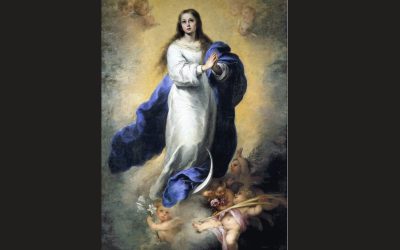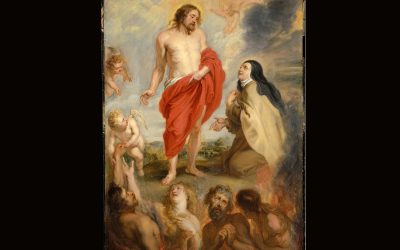By Amber Kinloch
Image by Nheyob sourced from Wikimedia Commons under CC BY-SA 4.0 license.
The month of May, traditionally dedicated to Mary, is an excellent time to cultivate or strengthen our devotion to our Blessed Mother. Amongst Catholics, the first thing that inevitably comes to mind is praying the Rosary—and with good reason! There is no devotion to Mary more blessed or exalted by popes and saints.
If you’ve never been in the habit of praying the Rosary, though, it can seem dull or intimidating. Or perhaps you feel in need of a “refresh” regarding your devotion to Mary. Or maybe you want to branch out and connect with her in other ways. Below are several little suggestions. I’ve divided them into different categories: vocal prayer, meditation, and deeds.
Vocal Prayer
After the Rosary, the Angelus is perhaps the most popular devotion to Mary amongst Catholics. This brief prayer is traditionally prayed at 6AM, 12PM, and 6PM. During the Easter Season, it is replaced by the Regina Caeli.
If you want to acquire the habit of praying the Angelus, I suggest a few things:
- Start small by praying it just once per day at whichever time is easiest for you.
- Use a timer or else associate praying it with some established part of your routine, e.g., when awaking in the morning or eating your lunch.
- Pray it well—slowly, sincerely, attentively. Don’t just “check the box.”
Another excellent idea for vocal prayer is Mother Teresa’s Flying Novena, which she prayed whenever she needed a favor in a hurry. It consists of ten Memorares, nine in petition for whatever the favor is and a tenth in thanksgiving for the granting of the aforementioned favor. It’s one of those handy devotions to keep in your backpocket and pull out as needed—and boy we do need a lot of favors! Think of how many anxieties crop up in the course of just a single day; this flying novena is an answer to those.
Contemplation
Building devotion to Our Lady isn’t just about reciting rote prayers. It’s about getting to know her as a person. We do this especially by contemplating her life.
Books like The Reed of God and Mary of Nazareth are a good place to start. These meditations, based upon the Gospel accounts, have helped bring Mary to life in my eyes and to see her as a real person instead of a mere historical figure.
Marian hymns are another favorite resource of mine. Many Catholics are familiar with “Immaculate Mary” and “Hail Holy Queen”. But how about “Virgin Full of Grace” or “Daily, Daily Sing to Mary”? “Maiden Yet a Mother” is a particular favorite of mine—it’s a tender piece suffused with profound reflections, e.g., “High beyond all other/Lowlier is none.”
How about cultivating devotion to Mary underneath a different title of hers that you’re not so familiar with or that especially resonates with you right now? Examples from the Litany of Loreto include: “Seat of Wisdom,” “Refuge of Sinners,” and “Cause of Our Joy.”
When words fail, artwork has a way of speaking to the human heart. We’re accustomed to seeing images of Mary alone or with Jesus and other familiar figures like Ss. Joseph and Elizabeth. After seeing the same sort of scene depicted in so many different ways, we can find ourselves automatically “passing by” such artwork. If you find yourself struggling with this, here are two suggestions:
- Look at something “fresh” like an image of St. Anne teaching Mary or the wedding of Mary and Joseph.
- Stop and really look. Take note of details like the expression of Mary’s eyes or how she gestures with her hand. Consider what these mean—perhaps Mary’s eyes are serenely closed as she cradles Christ to her breast. Maybe she is looking at you, inviting you to partake in her joy. Perhaps her expression is sad or serious as she mourns over the tragedy of sin and looks forward to what her Son will suffer because of it.
You might also pick a specific event from Mary’s life to reflect on at length (a day, a week, even longer) in association with something you’re currently experiencing. Do you grapple with selfishness and struggle to care about others? Think of Mary at the Wedding Feast of Cana and how zealous and attentive she is to others. Are you brimming over with happiness? Unite yourself with Mary as at the moment of the Annunciation when Christ has just come to her. Do you feel you’ve lost Jesus? Mary has experienced that. Whatever you’re undergoing, she knows and understands.
Deeds
Another way to cultivate devotion to Mary is to perform specific deeds in her honor.
A simple way is by wearing a Scapular or a Miraculous Medal. Or maybe you could carry a Rosary in your pocket and pray with it, or even just finger it when you’re suffering from some difficulty or temptation.
Enthrone an image of Mary in a prominent place in your home or workplace. Frequently salute her with a glance or an inclination of your head. Such little gestures will go far in keeping the fire of charity burning within you.
Imitating Mary’s virtues is a beautiful compliment to our Blessed Mother and a most pleasing act in God’s sight. Perhaps you might resolve to maintain a cheerful countenance throughout the day as Mary habitually did. Or you could imitate her prayerful silence by taking a break from the radio and listening more. How about imitating her service of neighbor by doing a chore for a family member or writing a friend a letter?
You might make an effort to mark Saturday—the day of the week traditionally dedicated to Mary—and Marian feast days by attending Mass, placing flowers by an image of her, and going out for ice cream. Bring along the family or a friend! Make these days special by consciously celebrating with Mary.
This is far from an exhaustive list of ideas. Exercise some creativity and find something that works for you. Go ahead and ask Mary herself what she’d like from you. She is your Mother. She will know best.
Below is a simple chanted version of the Salve Regina, i.e., the “Hail Holy Queen” we recite at the end of the Rosary. This piece reminds me of attending the funerals of some priests. When the Mass of Christian Burial is over, the priests will traditionally gather outside the church around the casket and chant the the Salve Regina. It’s very beautiful and moving to hear the priests bidding their brother farewell with this hymn.

Amber Kinloch
Amber writes from the bunker of her living room. There she hunkers down with her laptop and a blanket while keeping an eye and ear tuned in to the activity of family life. Music set on loop keeps her energy flowing as she muses on the deeper happenings of ordinary life and what food to restock the fridge with.






The old traditions are certainly worthy and productive, but the apparitions of Mary carry a greater content for me. Artwork represents the feelings of an artist – all very nice, but an actual image, such as the image of Our Lady of Guadalupe, reveals something special – beyond day-to-day reality. When the image was copied by painters for distribution throughout Europe, the Mary of the image moved north of Israel, toward Sweden. Many pious devotions presume facts that might or might not be true – and don’t have the intended effect. What Mary said at Tepeyac, Fatima, Lourdes, and now at Medjugorje is worthy of consideration because it draws us to Jesus.
I agree with you, James. Somehow those appearances draw me closer to her than devotions. There is Our Lady of Kibeho as well! Maybe it is because she has actually chosen to communicate with us directly through her appearances. We have been to Fatima and it was an awesome experience.